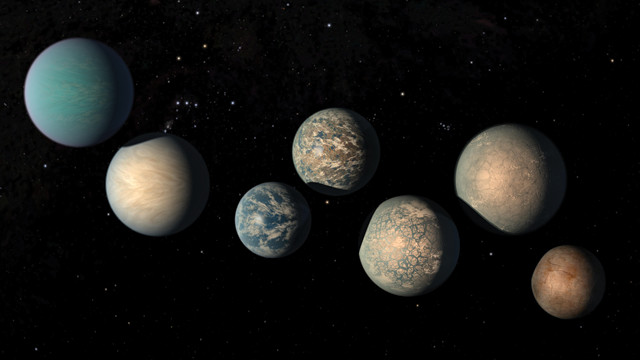
by Lucas Joel Tuesday, May 1, 2018

An illustration of the seven TRAPPIST-1 planets, which are all roughly Earth-sized. TRAPPIST-1e, fourth from the left, is considered the most Earth-like overall. Credit: NASA/JPL-Caltech.
In 2017, astronomers discovered seven planets orbiting a star dubbed TRAPPIST-1, a faint red dwarf 40 light-years from Earth and only 9 percent as bright as our sun. The Earth-like qualities of these planets made headlines: they are of similar sizes to our planet, and their orbits fall within TRAPPIST-1’s habitable zone — two characteristics that scientists think are important for life to exist on a planet. Researchers now report that the TRAPPIST-1 planets have even more traits in common with Earth: they are likely rocky, and they may have surface water that exists as liquid, ice and vapor.
Using data from the Spitzer and Kepler space telescopes, a team of scientists, led by astrophysicist Simon Grimm of the University of Bern in Switzerland, calculated the planets’ masses and densities. Knowing these two characteristics, Grimm explains, allows researchers to interpret what the interior structure of a planet is like. “Is it a gas planet or is it a rocky planet with a solid crust?” Grimm asks. “The most interesting fact about the TRAPPIST-1 planets is that all of the planets are similar to the Earth,” he says.
The planets are far too distant to see directly, even with the space telescopes. So, researchers study them by measuring, for instance, how much light the planets block as they pass in front of their host star. “The amount of light [a planet] blocks is proportional to the area of the planet,” says Ben Moore, an astrophysicist at the University of Zürich in Switzerland who was not involved in the research.
In a new study, published in Astronomy & Astrophysics, Grimm’s team used the “transit timing method,” which, Moore explains, accounts for how the gravity of each planet can alter the orbits of the other planets. “There are slight changes in the times that they pass [in front] of the star, because their orbits aren’t exactly as they would be if they were alone,” he says. Once the team had the data on the planets’ orbital variations, they used a computer model to estimate the planetary masses that best matched their orbital observations. The team determined “the masses, and therefore the densities, to an accuracy of 5 percent, which is pretty impressive for Earth-like planets 40 light-years away,” Moore says.
All of the planets, from TRAPPIST-1b (closest to the parent star) through TRAPPIST-1h, are rocky, and each probably contains a large amount of water, Grimm says — observations that weren’t available before this study. Water likely exists in different states on different TRAPPIST-1 planets because each one — depending on its distance from the star — receives more or less energy at its surface from the star. Grimm says that TRAPPIST-1e is the most Earth-like: “Planet e is the most similar in terms of mass, size and incoming energy flux from the star.” The planet’s mass is about 77 percent that of Earth’s, and its radius is about 91 percent. And because of its distance from its star, TRAPPIST-1e could very well have liquid water on its rocky surface.
The farthest planets in the system, TRAPPIST-1f, g and h, may only have frozen water on their surfaces, while those closer to the star, which receive more heat, likely have atmospheres thick with water vapor. TRAPPIST-1d, Grimm describes, is the lightest of the planets, but it is unclear what state water is likely in on its surface. Such fuzzy details should become clearer as more powerful telescopes, like the Extremely Large Telescope in Chile, come online in the next several years, Moore says.
It is only a matter of time until it could be possible to detect telltale signs of life on other planets — be it in the TRAPPIST-1 system or elsewhere, Moore says. “I think we’ll know in the next 20 years if there is life on these worlds.”
© 2008-2021. All rights reserved. Any copying, redistribution or retransmission of any of the contents of this service without the expressed written permission of the American Geosciences Institute is expressly prohibited. Click here for all copyright requests.